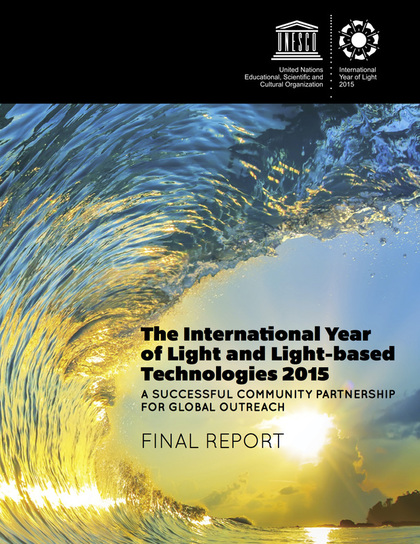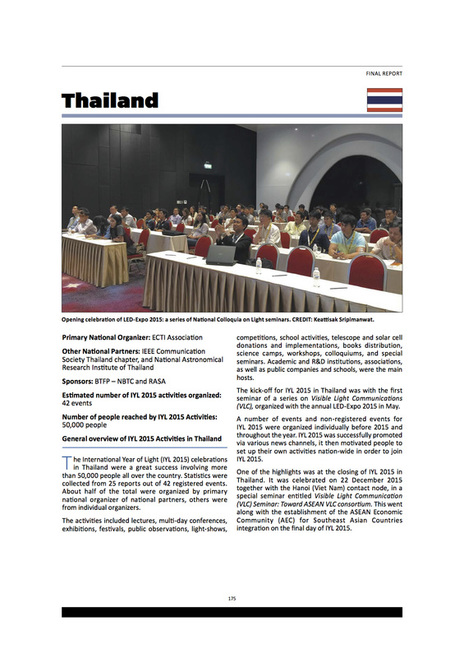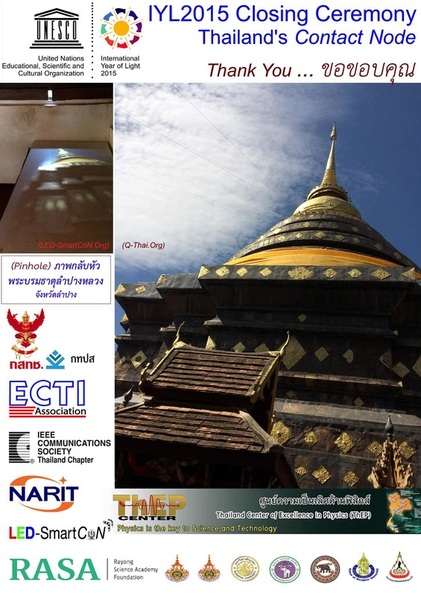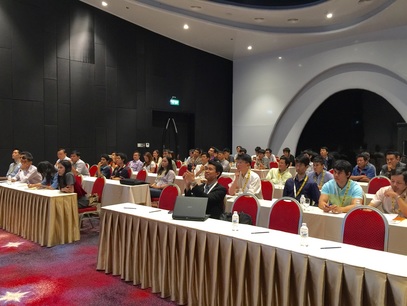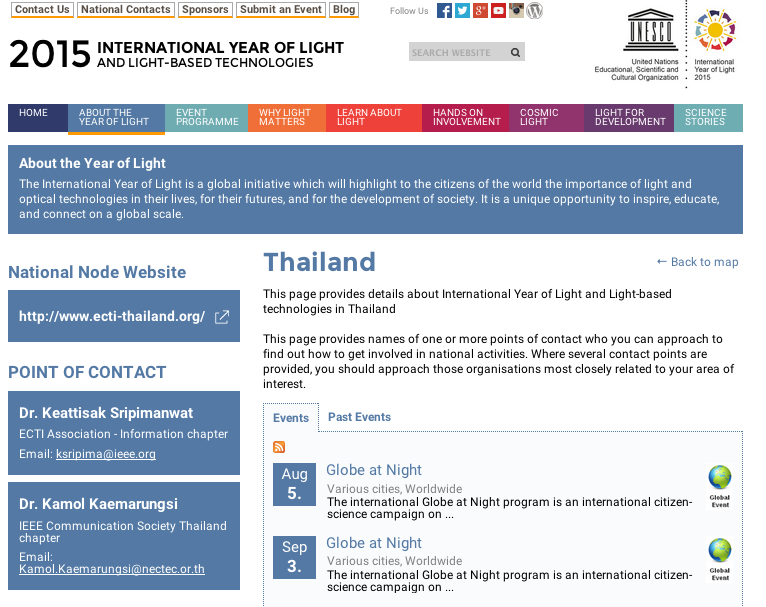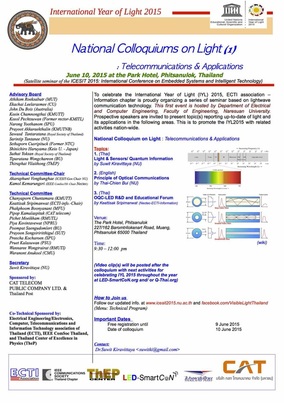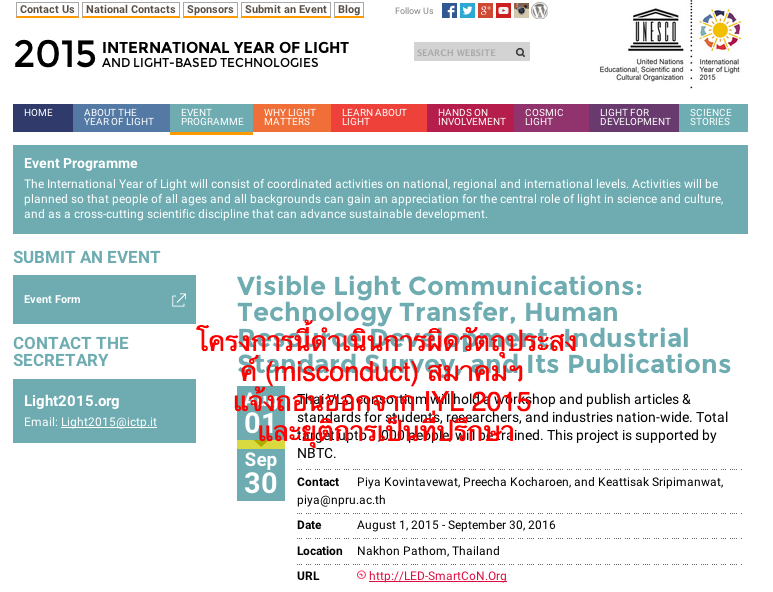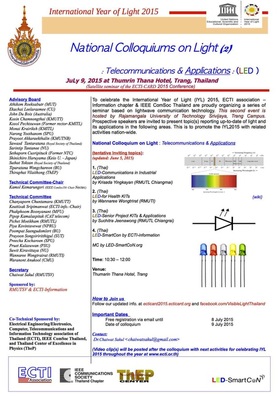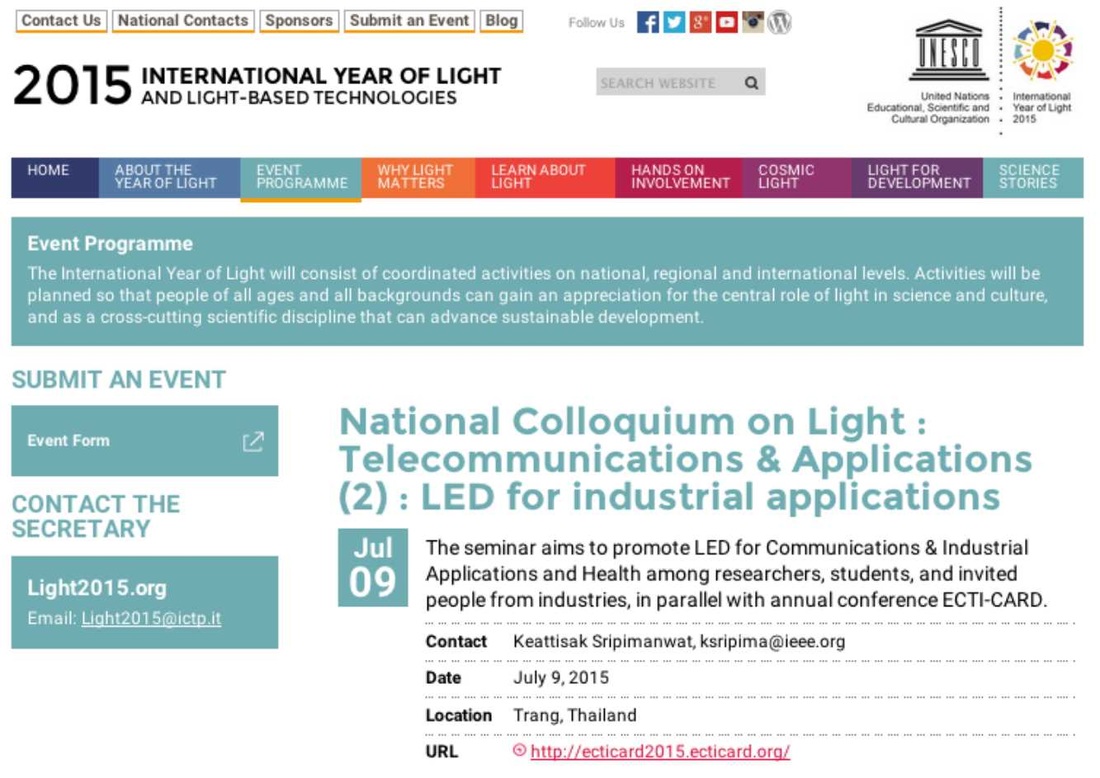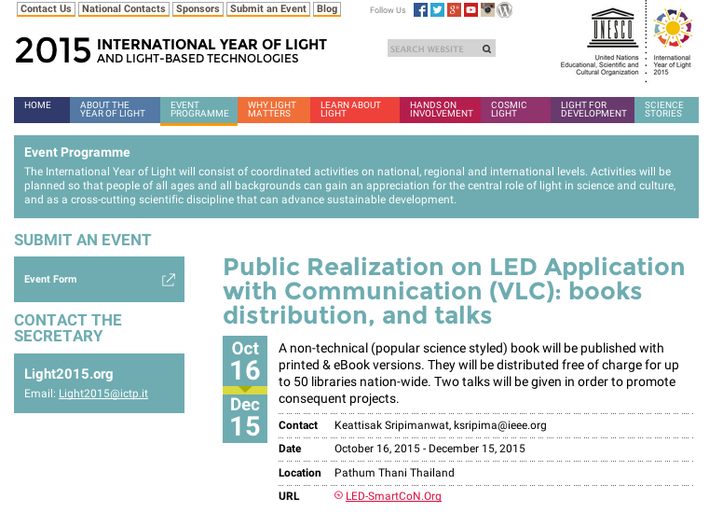ปีแห่งแสงสากลและเทคโนโลยีแสง พ.ศ.๒๕๕๘
กิจกรรมเพื่อช่วยสังคมความรู้ โดย สมาคมวิชาการไฟฟ้า อิเล็กทรอนิกส์ คอมพิวเตอร์ โทรคมนาคม และสารสนเทศแห่งประเทศไทย
National Colloquium on Light : Telecommunications & Applications
Kosin Chamnongthai (KMUTT) Kosol Pechtsuwan (Former rector-KMITL) Monai Krairiksh (KMITL)
Narong Yoothanom (SPU) Prayoot Akkaraekthalin (KMUTNB) Rungsun Channarukul (TOT plc)
Sawasd Tantaratana (Royal Society of Thailand) Sarintip Tantanee (NU) Sethaporn Cusripituck (Former NTC)
Shinichiro Haruyama (Keio U. - Japan) Suthat Yoksan (Royal Society of Thailand) Tiparatana Wongchareon (BU)
Thiraphat Vilaithong (ThEP)
(updated July 28, 2015)
Keattisak Sripimanwat (ECTI-info.-Chair) Kamol Kemarungsri (IEEE ComSocTH–Chair Nectec)
- Advisory Board
Kosin Chamnongthai (KMUTT) Kosol Pechtsuwan (Former rector-KMITL) Monai Krairiksh (KMITL)
Narong Yoothanom (SPU) Prayoot Akkaraekthalin (KMUTNB) Rungsun Channarukul (TOT plc)
Sawasd Tantaratana (Royal Society of Thailand) Sarintip Tantanee (NU) Sethaporn Cusripituck (Former NTC)
Shinichiro Haruyama (Keio U. - Japan) Suthat Yoksan (Royal Society of Thailand) Tiparatana Wongchareon (BU)
Thiraphat Vilaithong (ThEP)
(updated July 28, 2015)
- Point of Contact
Keattisak Sripimanwat (ECTI-info.-Chair) Kamol Kemarungsri (IEEE ComSocTH–Chair Nectec)
Activities: เกริ่นนำกิจกรรมสมาคม ECTI
|
ECTI Association and IEEE ComSoc Thailand chapter are volunteer to serve for IYL2015 as a contact point in Thailand. We are most in the area of communication and information engineering.
สมาคมวิชาการ ECTI และชมรมไฟฟ้าสื่อสาร สมาคมสถาบันวิศวกรไฟฟ้าและอิเล็กทรอนิกส์แห่งประเทศไทย (IEEE ComSoc Thailand) อาสาเป็นตัวแทนประเทศไทยเพื่อร่วมจัดกิจกรรมฉลองปีสากลแห่งแสงและเทคโนโลยีแสง พ.ศ.๒๕๕๘ โดยสาขาหลักจะเกี่ยวข้องกับด้าน ECTI เน้นสื่อสารโทรคมนาคม -------------------- สมาคมยินดีที่จะได้ช่วยส่งเสริมและจัดหาทุนจัดงานร่วมกับเจ้าภาพแต่ละแห่ง ดังตัวอย่างกิจกรรมก่อนหน้าด้านล่างนี้ (สำหรับกิจกรรมแสงด้านอื่น เช่น ดาราศาสตร์ สามารถติดตามได้จากเวปกลางของงานที่ http://www.light2015.org/ รวมทั้งเวปของสถาบัน ต่าง ๆ โดยตรง เช่น http://www.narit.or.th/index.php/iyl2015) -------------------- สาขาอื่นของสมาคม "สารสนเทศเชิงควอนตัม" Thai Quantum Information Forum โดยติดตามกิจกรรมฉลอง IYL2015 เพิ่มเติมได้ที่ Q-Thai.Org |
พื้นฐานการสื่อสารเชิงแสง
(Principle of Optical Communications)
(สารานุกรมโทรคมนาคมไทย 2009) การสื่อสารเชิงแสงเป็นการเพิ่มประสิทธิภาพของการสื่อสารโดยนำหลักการของแสงมาประยุกต์ใช้งาน ในการสื่อสารรูปแบบพื้นฐาน ภาคส่งจะรับข้อมูลทางไฟฟ้าจากแหล่งกำเนิดและจะใช้คลื่นพาห์ที่เป็นความถี่เชิงแสงโดยเลือกมาจากย่านที่ตามองเห็น รวมทั้งอินฟราเรดหรืออัลตราไวโอเลต จากนั้นนำมาผสมกับสัญญาณข้อมูลข่าวสารที่เป็นสัญญาณไฟฟ้า จนได้สัญญาณแสงออกมา แล้วนำสัญญาณแสงนั้นส่งออกไปทางช่องการสื่อสารเชิงแสง ซึ่งอาจเป็นอากาศ ชั้นบรรยากาศ หรือเส้นใยนำแสง เมื่อสัญญาณแสงส่งไปถึงยังภาครับ ภาครับจะทำการรวมแสงและส่งไปยังตัวตรวจจับแสงเพื่อทำการแยกสัญญาณออกจาก คลื่นพาห์ แล้วเปลี่ยนสัญญาณแสงเป็นสัญญาณไฟฟ้าเพื่อส่งให้อุปกรณ์ปลายทางต่อไป การสื่อสารเชิงแสงที่ใช้คลื่นพาห์ย่านแสงนั้น เป็นการใช้แบนด์วิดท์ของช่องสัญญาณที่กว้างมากของแสงทำให้สามารถส่งข้อมูล ได้ในปริมาณที่มากขึ้นและรวดเร็วขึ้นด้วย นอกจากนั้นสัญญาณแสงที่ส่งออกไปยังทำการตรวจจับหรือถูกรบกวนจากคลื่นความถี่ อื่นๆ ได้ยากกว่าช่วงคลื่นความถี่วิทยุ การสื่อสารเชิงแสงเหมาะสำหรับการสื่อสารความเร็วสูงเพื่อขนถ่ายข้อมูลปริมาณ สูงระหว่างเครือข่ายหลักหรือการประยุกต์เฉพาะทางอื่นๆ
Optical communication is one of the most advanced communications by using electromagnetic waves (of light form). It differs from radio and microwave communication in that the wavelengths employed are shorter (or higher frequency). Light as the transmission medium, the system employs its beam of modulated monochromatic light to carry information from the transmitter to the receiver. As a result, the transmission of speech, data, video, and other information by means of the visible and the infrared portion of the electromagnetic spectrum can be deployed. Basically, an optical communication system consists of a transmitter, which encodes a message into an optical signal, a channel of either free space or optical fiber, which carries the signal to its destination, and a receiver, which reproduces the message from the received optical signal. Obviously, the advantage of communication at high frequency of the optical carrier permits much more information to be transmitted over a single channel than it is possible with a conventional radio or microwave system. In addition, the very short wavelength of the optical carrier permits the realization of very small compact components.
Optical communication is one of the most advanced communications by using electromagnetic waves (of light form). It differs from radio and microwave communication in that the wavelengths employed are shorter (or higher frequency). Light as the transmission medium, the system employs its beam of modulated monochromatic light to carry information from the transmitter to the receiver. As a result, the transmission of speech, data, video, and other information by means of the visible and the infrared portion of the electromagnetic spectrum can be deployed. Basically, an optical communication system consists of a transmitter, which encodes a message into an optical signal, a channel of either free space or optical fiber, which carries the signal to its destination, and a receiver, which reproduces the message from the received optical signal. Obviously, the advantage of communication at high frequency of the optical carrier permits much more information to be transmitted over a single channel than it is possible with a conventional radio or microwave system. In addition, the very short wavelength of the optical carrier permits the realization of very small compact components.
(Other area of light tech to join IYL 2015 : Thai Quantum Information Forum at Q-Thai.Org and TeleSolar-R-Sa)
ครั้งที่ ๑National Colloquium on Light : Telecommunications & Applications (1)
|
ครั้งที่ ๒National Colloquium on Light : Telecommunications & Applications (2)
|
Optical Communication Milestones
ปี พ.ศ. (ค.ศ.) กับ ลำดับเหตุการณ์สำคัญ
(www.thaitelecomkm.org/TTM)
๒๓๓๓ (1790)
โคลด แชพพ์ (Claude Chappe) ประดิษฐ์โทรเลขเชิงแสง (click)
๒๔๒๓ (1880)
อเล็กซานเดอร์ เกรแฮม เบลล์ (Alexander Graham Bell) คิดค้นโทรศัพท์ใช้แสง (Photophone)
๒๔๖๓(1920)
จอห์น แบร์ด (John L. Baird) และ คลาเรนซ์ แฮนเซล (Clarence W. Hansell)
เสนอแนวคิดในการใช้เส้นใยแสงที่ไม่หุ้มฉนวนในการส่งสัญญาณภาพสำหรับโทรทัศน์
๒๔๙๔ (1951)
การพัฒนาเส้นใยแสงสำหรับใช้ในวงการแพทย์
๒๕๐๓ (1960)
ธีโอดอร์ ไมแมน (Theodore Maiman) ประดิษฐ์เลเซอร์ชนิดแรก
๒๕๐๗ (1964)
เกิดการคิดค้นแบบจำลองโทรศัพท์ภาพ (Picturephone) โดยบริษัทเอทีแอนด์ที (AT&T)
๒๕๐๙ (1966)
ชาร์เลส เค เกา (Charles K. Kao) แห่งศูนย์วิจัยมาตรฐานโทคมนาคม (Standard Telecommunications Laboratories: STL) สหราชอาณาจักร นำเสนอบทความเกี่ยวกับความเป็นไปได้ในการสร้างเส้นใยนำแสงที่มีความสูญเสียต่ำ (เพื่อการสื่อสารโทรคมนาคม)
๒๕๑๓ (1970)
ประสบความสำเร็จในการพัฒนาเส้นใยนำแสงที่มีความสูญเสียต่ำขึ้นมาใช้
ในการสื่อสารเป็นครั้งแรกโดยบริษัทคอร์นิ่งกลาส (Corning Glass Works) ของประเทศสหรัฐอเมริกา
|
|

